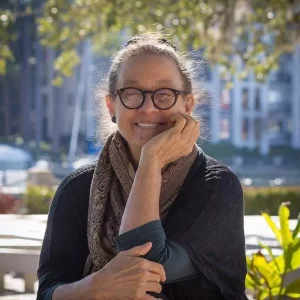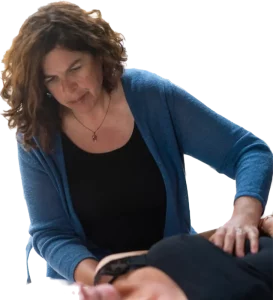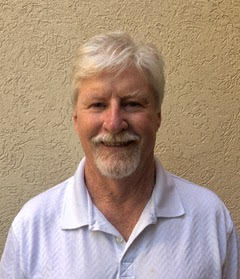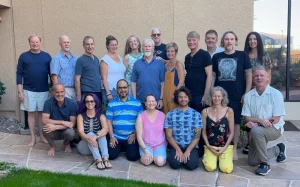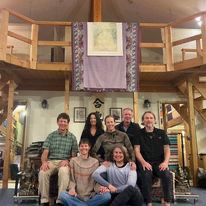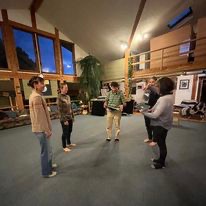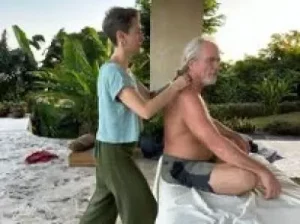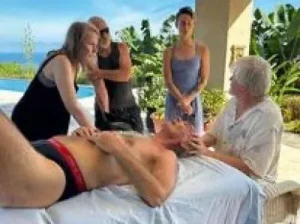Happy Holidays AGSI family!!
Wow! Do we have a story to tell! It was exactly 1 year ago this week that we had the Inspiration to start AGSI. Erin and I did not really know each other but had talked a few times about putting together a study group for experienced practitioners that would meet a four times a year. Our project had stalled a little and then GSI announced they were closing with an email on December 14. This started a little chain of events. I reached out to my friend David Davis and Erin reached out to me. When Erin and I talked there was a moment that we knew something was going to happen, though we didn’t know what the something was. Erin and I kept talking and on December 23 we had a zoom meeting with David that felt fertile. More talk led us to the obvious jump off point of actually meeting in person. See, Erin and I met for the first time in person on January 20, 2023. She sent me a picture from the airport of herself so I would recognize her when I picked her up in Tucson, AZ where David lives.
The three of us, David, Erin and myself spent the weekend meeting and planning the foundation of what was to become AGSI. When we left we actually had a date for our first workshop which was in Dallas, TX in April of this year. We have held 3 other workshops, the first module of our Teacher Training and our first Foundations of Structural Integration class in the last year. AND! We have more coming. Module 2 of our Teacher Training is in early January and that is quickly followed by our first ever Basic Training. As I write this I get overwhelmed by our fortune and how everything has laid out perfectly for us.
What’s coming Up!
Let’s talk about what is coming up in the near future.
ScarWork: Integrating Scar Tissue into the Fascial Web with Sharon Wheeler
February 29 – March 3, 2024 Montgomery, TX (near Houston)
This is our first time working with Sharon and we are really excited to host her ground breaking workshop.
Working with scars is like speaking a different language in the world of connective tissue, and the ScarWork approach is like a gentle, textural art form. With ScarWork’s specialized techniques, tissue quality improves quickly and easily, and contours in the scar smooth out and re-integrate into the body’s three-dimensional fascial web. ScarWork often results in profound functional changes as well as delightful cosmetic improvements. Frequently the results encompass whole-body integration shifts along with trauma resolution. The results appear to be permanent.
In 1970, at the age of 23, Sharon Wheeler trained with Dr. Rolf as an “artistic experiment”. This way of learning Structural Integration gave rise to ScarWork and BoneWork, Sharon’s unique discoveries and contributions to the field.
Here is a short video of Jeannie Kelly talking about ScarWork:
A Creative Exploration of Post-Ten Within a 3 Series with Liz Stewart
May 2 – May 5,2024 in Boulder, CO
For a long time Liz Stewart has had a big impact on the Structural Integration community. When I met her in 2000 she was working at the GSI office in Boulder and spending a lot of time with Peter Melchior. Watching Liz commit to learning her craft and to spend her time with mentors really taught me how to persue my own potential in this work. I learned that we don’t need to live on an island and reinvent the wheel in order to become excellent practitioners. This workshop is maybe my favorite topic of all, fundemental Structural Integration. For most of our clients the Basic 10 Series is just a beginning and the really great changes can happen afterwards. Offerin a really solid Post 10 Three Series is a tremendous service and can really help people move forward. It doesn’t matter how long you have been in practice, this workshop will up your game and help you develop community with fellow practitioners as well.
What do we do when our Structural Integration clients come back for more work following their 10 Series? How do we make a Post-Ten Series unique for each client? While there is a basic framework for these “tune-up” sessions, it is an opportunity for creativity and exploration. Please join us for a workshop devoted to the Post-Ten 3-Series, with an emphasis on tracking, movement, “seeing,” making contact, and investigating layers.
Liz Stewart is an Advanced Structural Integration Practitioner based in Boulder, CO. She trained in 1991-92 with the Guild For Structural Integration (GSI) in Sao Paulo, Brazil and Boulder, CO with direct students of Dr Ida P Rolf. She also has an extensive background in mentoring both with groups and individuals and has been offering mentoring support within the SI community for over 15 years.
Advanced Training with David Davis
May 06 – May 23, 2024 Tucson,AZ
In early May in Tucson, AZ we are starting a three week long Advanced Training. We have condensed the time to three weeks but we are still teaching the Classic Advanced 5 Session Series that was developed in the 70’s by Dr. Rolf, Peter Melchior and Emmet Hutchins. The classic positions (the Z, C, and L) are creatively utilized to stress the structure to a certain degree exposing where more alignment can be refined after having completed the Basic 10 Series. I believe our sister program EGSI and us, AGSI, are the only ones still teachiung the classic Advanced 5 Series. May can be the best month in Tucson and studying with David should not be missed.
What Have We Been Up Too?
We have had an amazing fall. It started in October with our Teacher Training Module 1 in Tucson, AZ. We have 15 amazing practitioners joining our family at AGSI. David Davis taught the class and Ritchie Mintz joined us for the 4 days and selflessly chipped in his services. We are so lucky to have everyone involved. One of our first goals at AGSI is to develop the next generation of teachers to carry on Dr. Rolf’s vision. As a program are very traditional in our training, using the traditional immersion style and the proven phases of Foundations of Structural Integration, Practitioning and Auditing in our Basic Training. The Basic 10 Series is the heart of our program. We spent the 4 days immersing ourselves into the spirit of Dr. Rolf really trying to embody her ideas and to make them a deep part of our teaching philosophy. We talked about the series, history and really thought about where we have come from.
We had another landmark course this fall by holding our first Foundations of Structural Integration Course in Crestone, CO. FOSI is our prerequisite class for our Basic Training Program. Our old friend and colleague Buddy Frank taught the class and we had three graduates that will be moving on to our Basic Training classes in 2024. The focus of the course is Structural Integration Anatomy and Informed touch where the students learned the skills to be able to perform a bodywork session using their new skills and knowledge as they practice and prepare for their Basic Training. Congratulations to our FOSI graduates and good luck in your future training.
In Montezuma, Costa Rica David Davis and Will Johnson joined forces to teach a workshop “Embodiment and Evolutionary Transformation Through the Line”. David and Will have been planning this workshop for 20 years and it did not disappoint. This was the first workshop AGSI has hosted that I was not able to attend but the feedback has been amazing with the common theme being “this workshop should be mandatory for every practitioner”. My friend Chris Estrem said
“I’ve been going to workshops for years and this workshop was by far the most impactful. I now have two powerful allies in life, the line and my breath.”
We will be hosting this workshop again.
Check out this quick video:
What am I thinking about now?
As Structural Integration Practitioners we are trained to see and to work with patterns. Everything I am going to say is based on my annectdotal experience, from my observations from the clients that I have worked with over the years and from bits and pieces of what I’ve read and maybe even some things that I have made up. All good things start with a hypothesis, Right? Well, I have an obvious pattern in my practice right now. Last week I had three clients have total knee replacement surgery and in the last year I have had two others also have knee replacement surgery. On top of that, I’ve had 4 clients have meniscious surgery. That’s 9 knee surgeries that I have been a part of in the last 12 months. At one point in my practice I would have thought of that result as a failure because I believed that orthopedic surgery was to be avoided at all costs. I no longer think that way after watching many clients have their lives shrink into a tiny box because of immobility, pain and stubborness and then watch them reclaim their lives after a successful surgery. Of the 9 clients with knee surgeries this year I supported 8 of them in their decision process and one came to me for help with the recovery from his first knee surgery with his second alreadsy scheduled. Many times our clients come to us after they are past the point of avoiding surgery or we successfully help them avoid surgery for a period of time but it is important for me to remember that surgery is not a failure. In many cases it is awesome. What we are the BEST of all Treatments at is the integration of the surgery sight into the whole being. Whether it is a partial or total miniscectomy or a total knee replacement there has been a huge structural and functional interuption or dis-integration. Our clients desperitely need our help to maximize their potential to not just recover from surgery but to thrive with new opportunity as they move forward. David Davis told me once “they can never be the same as they were but that doesn’t mean they can’t be better”. This is a very powerful belief system that we can bring to our clentelle and to the world.
The shift in my understanding started about 15 years ago when I had a client walk in after 2 “successful” full knee replacemt surgeries. He didn’t walk into my office, he hobbled into my office. Never once did he complain about his knees, he was there to avoid neck surgery. In my observation, his body had functioning knee joints in a mechanical sense but his nervous system did not trust them and his base of support was letting him down. In his case the focus of the compensatory strain was in his cervical spine. After completing the Basic 10 Series he had an amazing base of support, no neck pain and the ability to hike off-trail in the mountains, do hard leg workouts and cycle freely. His legs are very integrated into his whole being. With my current clients that is my goal with every session I do post surgery, acutally in every session I do, I work with the line and integration. I begin working with post-surgery clients ASAP, the sooner the better. I have worked with them as soon as one week after the surgery and if they are a regular client that I have a relationship with I don’t wait more than four weeks post-surgery. This does not mean I am working on their surgery site, I am working to create balance in their structure, to get weight back onto the insulted leg. A long time ago I read in Jim Oschman’s book “Energy Medicine” that strain causes a piso electric charge and that fascial healing follows the electric charge. So, I think that the more I can help someone get beyond the compensatory patterns post-surgery and into natural balance the more it helps create healthy strain patterns in the bones and tissues therefor expediting the healing process. Here is where I make stuff up, I believe from my experience that this dramatically speeds up the healing process in ways that are impossible to measure. I also have observed over and over that my clients with prosthetic joints, whether knees or hips function noticibly better then “random” bodies who do not use Structural Integration to help them heal and to thrive. The last thought I have on working with clients with prosthetic joints is that they need to receive regular work to stay healthy in their structure. No matter how integrated they are with our awesome work they will always have a piece of themselves that is pulling them into compensation and off Line. It is a great service to see them regularly and not just to keep them out of pain. We can help them become more and more resilient, balanced and healthy as we work with them towards their line and their potential.
